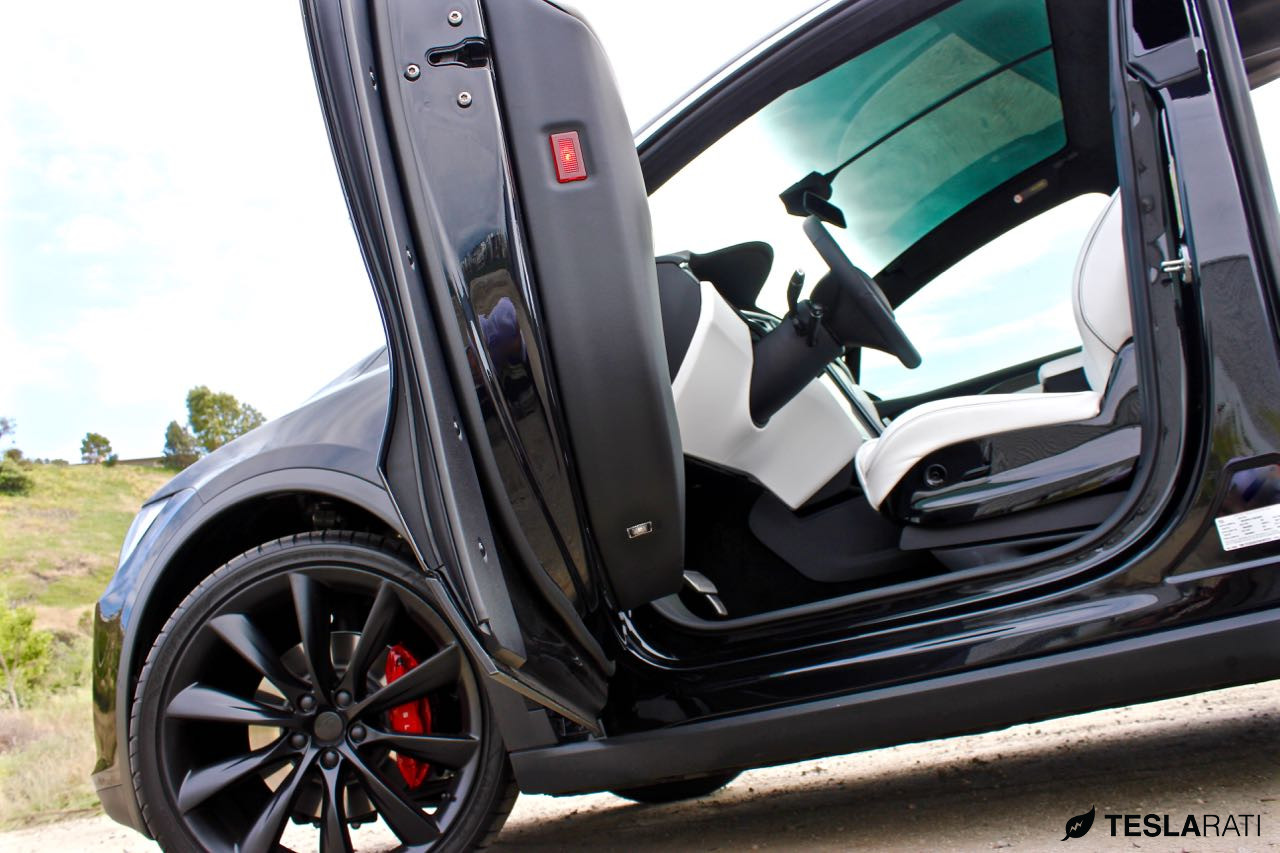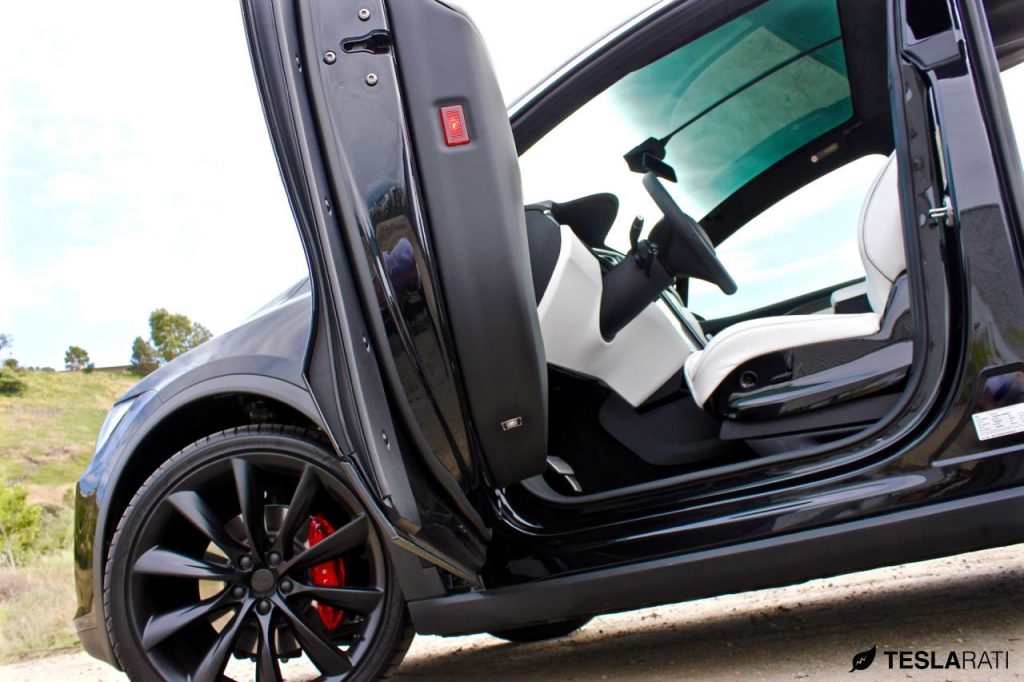News
Tesla Model X owner files for Lemon Law protection claiming unfixable defects

The first Lemon Law suit that we know of has been filed by a California man over the claim that his $162,000 Tesla Model X exhibits ‘weird’ behavior and is dangerous to drive.
Model X owner Barrett Lyon filed suit at Placer County Court in Roseville, CA claiming that the vehicle’s electronically actuated doors have slammed shut on his leg as well as damaged property as a result of its behavior. According to the Courthouse News Service (CNS), Lyon said “The doors do some weird, wicked things. If you get in and slide sideways and accidentally tap the brake, the driver’s side door slams shut on your leg. That’s not a very nice thing to have happen to you.”
Tesla Model X self-presenting front doors
The doors he’s referring to isn’t the Model X’s unique dual-hinged falcon wing doors that open out and upwards. Rather, Lyon is claiming that the vehicle’s sophisticated self-presenting and auto-closing front doors have swung open in their garage resulting in damage to the door and other property.
Among other issues being cited in the Lemon Law suit are (quoting Lyon via CNS):
- “Auto Pilot in the rain is extremely dangerous, it causes the car to swerve into different lanes.”
- “Powered front doors are opening into cars and other obstacles.”
- “The power door slams are a feature of the Model X, and cannot be disabled”
- “The touch screen freezes repeatedly, the second row seat causes driver’s seat to fold forward, and the auto park feature does not work 90 percent of the time,”
What’s interesting about this case is that Lyon would appear to be a long time supporter of Tesla being an owner to a Roadster as well as a Model S which he states have not given him any troubles. The Model X on the other hand has been a disappointment and thus remains undriven. “It’s parked. We don’t drive it. It’s basically a really fancy car decoration.”, says Lyon.
Lyon’s suit wouldn’t be the first time Tesla was faced with a Lemon Law challenge. Back in early 2014, the self-proclaimed “Lemon Law King” represented a Model S owner who claimed his newly bought vehicle at the time was out of service for a total of 66 days shortly after his March 2013 purchase due to alleged defects which prevented the vehicle from turning on and driving. Tesla quickly fired back releasing a statement on their blog defending their position, but also questioning the true motives behind the suit.
This new Lemon lawsuit brought on by Lyon and represented by San Francisco based law firm Anderson, Ogilvie & Brewer could have some merit especially with more widespread reports of the over-engineered “Best car ever” facing quality issues. Tesla CEO Elon Musk continues to reassure potential buyers that the company has increased its quality checks. Musk has gone as far as saying that he personally checks vehicles for quality and has set up a sleeping bag at the end of the production line where he sleeps.
Lyon seeks a refund on the purchase of the vehicle including registration fees. He also seeks damages for breach of warranty and lawyer fees.
Below is a copy of what the California Office of Attorney General defines as the Lemon Law.
California “Lemon Law”: A special provision, often called the “Lemon Law,” helps determine what is a reasonable number of repair attempts for problems that substantially impair the use, value, or safety of the vehicle. The “Lemon Law” applies to these problems if they arise during the first 18 months after the consumer received delivery of the vehicle or within the first 18,000 miles on the odometer, whichever occurs first. During the first 18 months or 18,000 miles, the “Lemon Law” presumes that a manufacturer has had a reasonable number of attempts to repair the vehicle if either (1) the same problem results in a condition that is likely to cause death or serious bodily injury if the vehicle is driven and the problem has been subject to repair two or more times by the manufacturer or its agents, and the buyer or lessee has at least once directly notified the manufacturer of the need for the repair of the problem as provided in the warranty or owner’s manual or (2) the same problem has been subject to repair four or more times by the manufacturer or its agents and the buyer has at least once directly notified the manufacturer of the need for the repair of the problem as provided in the warranty or owner’s manual or (3) the vehicle is out of service because of the repair of any number of problems by the manufacturer or its agents for a cumulative total of more than 30 days since delivery of the vehicle.

News
Tesla FSD fleet is nearing 7 billion total miles, including 2.5 billion city miles
As can be seen on Tesla’s official FSD webpage, vehicles equipped with the system have now navigated over 6.99 billion miles.

Tesla’s Full Self-Driving (Supervised) fleet is closing in on almost 7 billion total miles driven, as per data posted by the company on its official FSD webpage.
These figures hint at the massive scale of data fueling Tesla’s rapid FSD improvements, which have been quite notable as of late.
FSD mileage milestones
As can be seen on Tesla’s official FSD webpage, vehicles equipped with the system have now navigated over 6.99 billion miles. Tesla owner and avid FSD tester Whole Mars Catalog also shared a screenshot indicating that from the nearly 7 billion miles traveled by the FSD fleet, more than 2.5 billion miles were driven inside cities.
City miles are particularly valuable for complex urban scenarios like unprotected turns, pedestrian interactions, and traffic lights. This is also the difference-maker for FSD, as only complex solutions, such as Waymo’s self-driving taxis, operate similarly on inner-city streets. And even then, incidents such as the San Francisco blackouts have proven challenging for sensor-rich vehicles like Waymos.
Tesla’s data edge
Tesla has a number of advantages in the autonomous vehicle sector, one of which is the size of its fleet and the number of vehicles training FSD on real-world roads. Tesla’s nearly 7 billion FSD miles then allow the company to roll out updates that make its vehicles behave like they are being driven by experienced drivers, even if they are operating on their own.
So notable are Tesla’s improvements to FSD that NVIDIA Director of Robotics Jim Fan, after experiencing FSD v14, noted that the system is the first AI that passes what he described as a “Physical Turing Test.”
“Despite knowing exactly how robot learning works, I still find it magical watching the steering wheel turn by itself. First it feels surreal, next it becomes routine. Then, like the smartphone, taking it away actively hurts. This is how humanity gets rewired and glued to god-like technologies,” Fan wrote in a post on X.
News
Tesla starts showing how FSD will change lives in Europe
Local officials tested the system on narrow country roads and were impressed by FSD’s smooth, human-like driving, with some calling the service a game-changer for everyday life in areas that are far from urban centers.

Tesla has launched Europe’s first public shuttle service using Full Self-Driving (Supervised) in the rural Eifelkreis Bitburg-Prüm region of Germany, demonstrating how the technology can restore independence and mobility for people who struggle with limited transport options.
Local officials tested the system on narrow country roads and were impressed by FSD’s smooth, human-like driving, with some calling the service a game-changer for everyday life in areas that are far from urban centers.
Officials see real impact on rural residents
Arzfeld Mayor Johannes Kuhl and District Administrator Andreas Kruppert personally tested the Tesla shuttle service. This allowed them to see just how well FSD navigated winding lanes and rural roads confidently. Kruppert said, “Autonomous driving sounds like science fiction to many, but we simply see here that it works totally well in rural regions too.” Kuhl, for his part, also noted that FSD “feels like a very experienced driver.”
The pilot complements the area’s “Citizen Bus” program, which provides on-demand rides for elderly residents who can no longer drive themselves. Tesla Europe shared a video of a demonstration of the service, highlighting how FSD gives people their freedom back, even in places where public transport is not as prevalent.
What the Ministry for Economic Affairs and Transport says
Rhineland-Palatinate’s Minister Daniela Schmitt supported the project, praising the collaboration that made this “first of its kind in Europe” possible. As per the ministry, the rural rollout for the service shows FSD’s potential beyond major cities, and it delivers tangible benefits like grocery runs, doctor visits, and social connections for isolated residents.
“Reliable and flexible mobility is especially vital in rural areas. With the launch of a shuttle service using self-driving vehicles (FSD supervised) by Tesla in the Eifelkreis Bitburg-Prüm, an innovative pilot project is now getting underway that complements local community bus services. It is the first project of its kind in Europe.
“The result is a real gain for rural mobility: greater accessibility, more flexibility and tangible benefits for everyday life. A strong signal for innovation, cooperation and future-oriented mobility beyond urban centers,” the ministry wrote in a LinkedIn post.
News
Tesla China quietly posts Robotaxi-related job listing
Tesla China is currently seeking a Low Voltage Electrical Engineer to work on circuit board design for the company’s autonomous vehicles.

Tesla has posted a new job listing in Shanghai explicitly tied to its Robotaxi program, fueling speculation that the company is preparing to launch its dedicated autonomous ride-hailing service in China.
As noted in the listing, Tesla China is currently seeking a Low Voltage Electrical Engineer to work on circuit board design for the company’s autonomous vehicles.
Robotaxi-specific role
The listing, which was shared on social media platform X by industry watcher @tslaming, suggested that Tesla China is looking to fill the role urgently. The job listing itself specifically mentions that the person hired for the role will be working on the Low Voltage Hardware team, which would design the circuit boards that would serve as the nervous system of the Robotaxi.
Key tasks for the role, as indicated in the job listing, include collaboration with PCB layout, firmware, mechanical, program management, and validation teams, among other responsibilities. The role is based in Shanghai.
China Robotaxi launch
China represents a massive potential market for robotaxis, with its dense urban centers and supportive policies in select cities. Tesla has limited permission to roll out FSD in the country, though despite this, its vehicles have been hailed as among the best in the market when it comes to autonomous features. So far, at least, it appears that China supports Tesla’s FSD and Robotaxi rollout.
This was hinted at in November, when Tesla brought the Cybercab to the 8th China International Import Expo (CIIE) in Shanghai, marking the first time that the autonomous two-seater was brought to the Asia-Pacific region. The vehicle, despite not having a release date in China, received a significant amount of interest among the event’s attendees.









